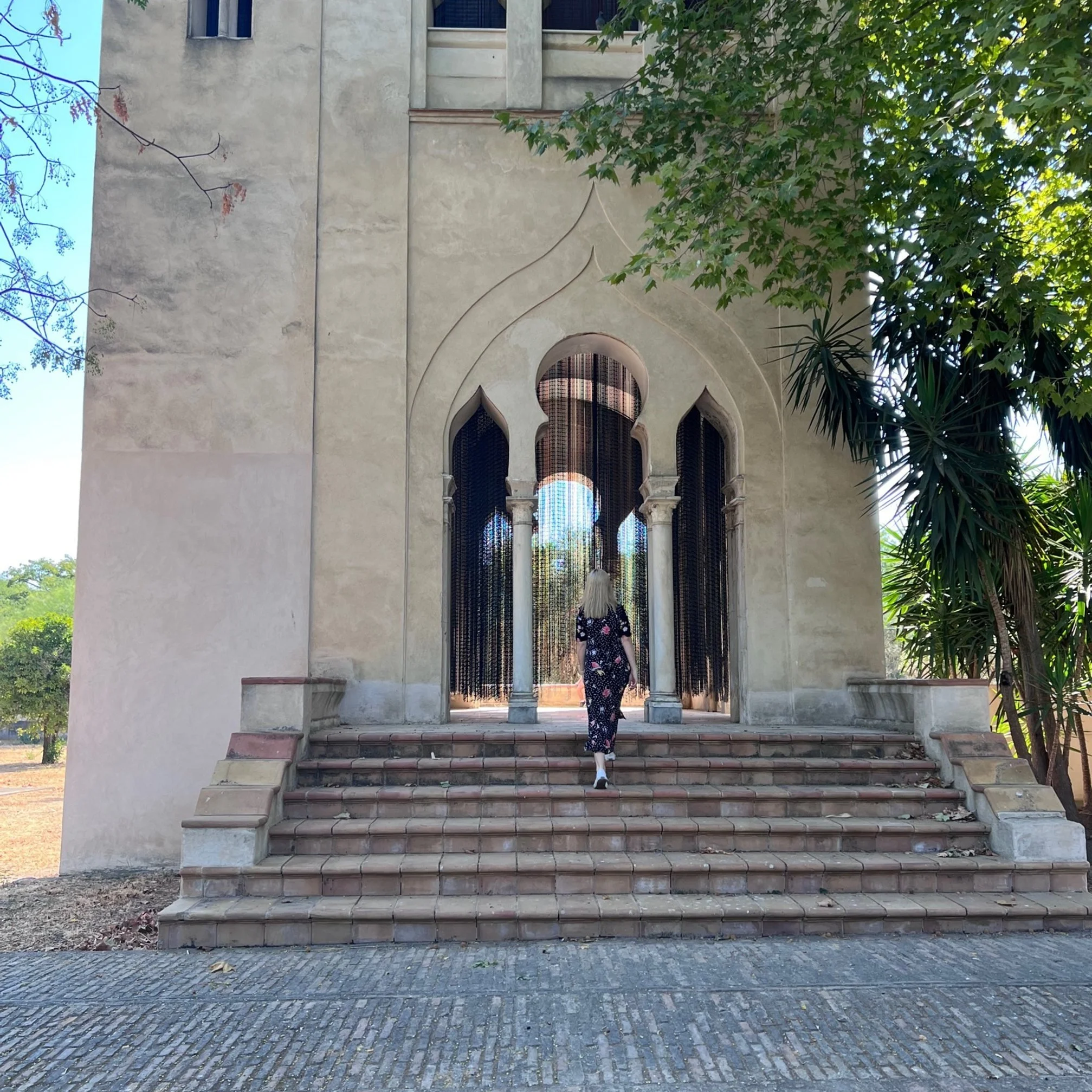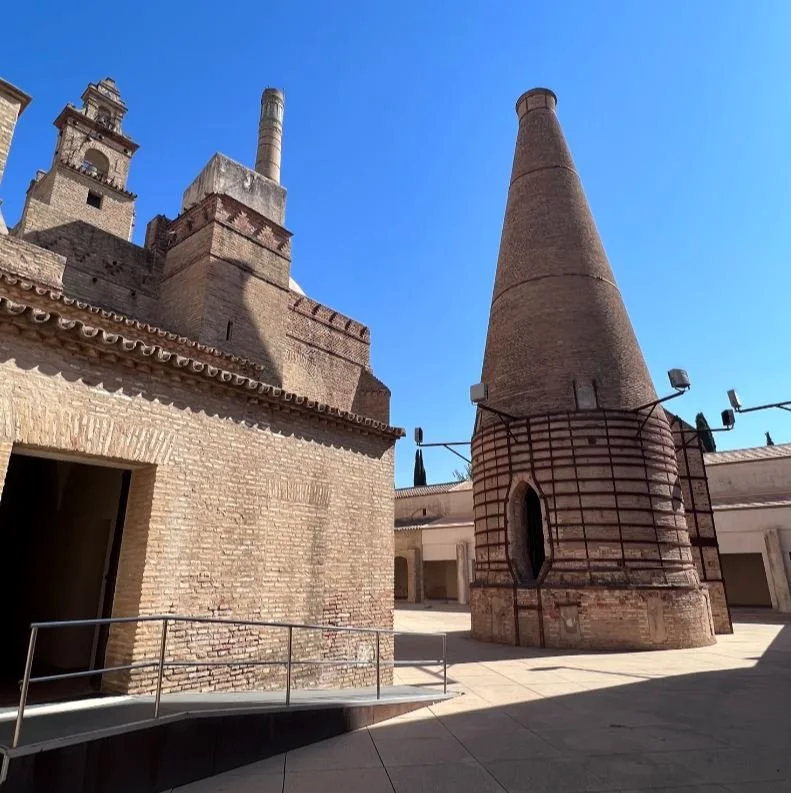Andalusian Centre for Contemporary Art - All You Need To Know
The Andalusian Centre for Contemporary Art (CAAC), or Centro Andaluz de Arte Contemporaneo in Spanish, is the premier contemporary art museum in Seville and Andalusia, holding over 3,000 works of art, many of which are on display.
Since 1998, it has been located in the monastery of Santa María de las Cuevas. As the name suggests, this venue was once a monastery, that later became a ceramics factory, with iconic brick kiln chimneys and is now a contemporary art museum. The contrast between the historical setting and contemporary art makes for a unique visitor experience.
The Andalusian Centre for Contemporary Art is located on the Isla de la Cartuja, which is across the Guadalquivir river from the busy streets of Seville’s historic centre. It has a relaxing and quiet atmosphere, perfect for taking in the exhibitions at the art gallery and museum.
In this blog post I have set out a guide to the Andalusian Centre for Contemporary Art to help you plan your visit there.
I have written a separate blog post about other amazing sights you can visit in Seville, which you can read here.
Table of Contents
About the Andalusian Centre for Contemporary Art (CAAC)
The Key Exhibition Rooms and Spaces at Andalusian Centre for Contemporary Art
The Gardens at Andalusian Centre for Contemporary Art
A Brief History of The Monastery of Santa María de las Cuevas
About the Andalusian Centre for Contemporary Art (CAAC)
One of the main objectives of the Andalusian Centre for Contemporary Art (Centro Andaluz de Arte Contemporaneo) is to develop a programme of educational activities that promote contemporary artistic expression. This is evident as you walk around the gallery, exploring the artworks on display and discovering what the centre has to offer. This includes:
Late 20th Century works by Sevillian artists, such as Luis Gordillo, Federico Garcia Lorca and Equipo 57;
Extensive temporary exhibitions held throughout the year, covering a variety of themes;
Sculptural collections in the gardens;
Music concerts, such as the Soulville Black Music Festival, and jazz sessions.
The CAAC also has a large contemporary art library that contains 26,000 volumes of material.
The Key Exhibition Rooms and Spaces at the Andalusian Centre for Contemporary Art
There are several historic rooms within the monastery, some of which now house contemporary art collections.
As you approach the building from the Avsa. Americo Vespucio entrance, you will spot some permanent art pieces. For example, at the entrance gateway and the Capilla De Afuera (the outer chapel), you will see ‘Alicia’ by Juanna de Aizpura and Christina Lucas Donation, a large art installation that displays a gigantic figure whose face and arm protrude form the open window.
The chapel has an internal space where art is also displayed. On our visit we viewed the artwork ‘Los Träbäjos’ by the American artist Pae White.
The Artio E Iglesia is the atrium and 15th Century gothic church, and acts as the main entrance to the Andalusian Centre for Contemporary Art. This building was also used as a pottery warehouse in the 19th Century. It is now used as an exhibition hall and a space to host cultural events and display artworks. The Capilla de Santa Ana (St Anne’s Chapel) is located off this building, and it was here that the body of Christopher Columbus lay between 1509 to 1536.
There is artwork at every turn - we were fascinated by the installation ‘Stoner’ by the Romanian artist Andra Ursuta and the sculptures by Giulia Cenci, which form part of the series titled ‘Territory’, which appear to invade and occupy the chapel space.
Claustrillo (Little Cloisters) is an atmospheric space that is also one of the best examples in Seville of Mudéjar architecture, with its roof tiles, glazed tiling in the galleries, red brick and white marble columns. Magdelena’s Chapel is located off this cloisters - a video installation was on display in this room during our visit.
The series of gallery spaces wrap around the chapel buildings and are accessed by walking through the courtyards and under some fruit trees.
We particularly enjoyed the exhibition ‘Voluntad de objeto’ (‘Objectual Will') by Rubén Guerrero:
Other favourite works included ‘Bang-Bang Room’ by Paul McCarthy and ‘Heritage Studies’ by Iman Issa.
The Peurta Del Rio (River Door), is located at the Camino de Los Descubrimientos entrance. This door is characterised by the ceramic finials and reused diamond-shaped tiles that give the doorway a decorative appearance.
The Gardens at Andalusian Centre for Contemporary Art
The gardens are extensive and contain large areas of landscaping, as well as numerous buildings.
There is also a café with an attractive outdoor seating area.
There are two chapels in the gardens, one dedicated to Saint Anne and the second is called Chapel of Saints Justa and Rufina. This second chapel was modified by Charles Pickman to reflect the 19th century British garden pavilions architecture. I have included further information about Charles Pickman later in this blog post.
The mudéjar torrejon (mudejar tower) in the gardens is worth exploring with its beaded curtains by Olaf Nicolai, set within the doorways.
In the gardens you will also find ombu (Phytolacca dioica), a type of grass that grows to about 15 metres. It is believed that ombu was planted by Hernando Colón, the son of Christopher Columbus.
A Brief History of The Monastery of Santa María de las Cuevas
The Monastery of Santa María de las Cuevas is a very unique building in which to house a contemporary art gallery. This building complex has had quite a colourful history, and it seems unusual, yet fitting that it has become a contemporary art gallery and museum.
Visitors to the Andalusian Centre for Contemporary Art (Centro Andaluz de Arte Contemporaneo) will also appreciate the historical context in which it is located, by exploring the grounds of the former monastery, including the chapels of Santa Catalina, San Bruno, and Santa Ana, the cloisters, gardens and orchards.
The Monastery of Santa María de las Cuevas is located on the Isla de la Cartuja, an area rich in clay deposits. Legend has it that a figure of the Virgin Mary was found here during a clay excavation, which led to pilgrimages to the area.
A monastery was then founded here around the 1410s. The monastery was built with a Gothic façade and is a good example of Mudejar architectural decoration.
The monastery had a number of famous and prominent visitors over the years, including the explorer Christopher Columbus, who regularly stayed here with his family before his voyages to the New World. I mentioned earlier in this post that the body of Christopher Columbus lay here between 1509 to 1536. His brother, Diego Columbus, is buried here to this day.
In mid-19th century, an English businessman, Charles Pickman, originally from Liverpool, purchased the monastery and turned it into an internationally renowned pottery factory, under the brand La Cartuja. Charles Pickman renovated the building and introduced the bottle-shaped chimneys. In the 1950s the original chimneys ceased to be used and other tunnel-type chimneys were introduced to the site.
Following the closure of the factory in the 1980s, the Monastery was then restored in the 1990s for use as a cultural centre during the Universal Exhibition of 1992. In 1998, the Monastery of Santa María de las Cuevas became home to the Museum of Contemporary Art of Seville.
How to get to the Andalusian Centre for Contemporary Art
There are two entrances to the Andalusian Centre for Contemporary Art:
The main entrance is located on Calle Americo Vespucio. From here you can walk through the grand archway to the monastery.
The second entrance is from Camino de Los Descubrimientos. This entrance will take you through the tiled Puerta del Rio entrance, and past the kiln-chimneys and factory buildings.
The official address is Cartuja de Santa María de Las Cuevas, Camino de los Descubrimientos, s/n 41092 Sevilla.
The Andalusian Centre for Contemporary Art is a little way out from the centre of Seville.
We found it easiest to travel by taxi to this gallery. However, when leaving, there are not many taxis around, so it will require walking either to the Torre Seville Shopping Centre or C. Torneo.
To walk, it is about 1.6km from Las Setas and can be reached by walking towards Calle Alfonso XII and meandering towards the Pasarela de la Cartuja Bridge.
Bus services C-1, C-2 and 5 also serve the Andalusian Centre for Contemporary Art. These stop along Calle Americo Vespucio.
By car, there is parking next to the Camino de los Descubrimientos entrance, which is by the Pasarela de la Cartuja Bridge, or in the Torre Sevilla underground car park, which offers free parking for a limited time.
Opening Hours
The Andalusian Centre for Contemporary Art is open:
Tuesday to Saturday: 11.00 - 21.00
Sunday and holidays: 11.00 – 15.30
Monday: Closed
Admission
The entry cost is €1.80 per adult, children are free.
These opening times and prices are correct at the time of writing this blog post, but please check the latest information before your visit.
I hope you have found this blog post useful. If you have visited this art gallery, I would love to hear your thoughts or if you feel anything is missing from the list, please email me and let me know at sarahransomeart@gmail.com.
Please see my blog post 7 Best Things to do in Seville, Spain, for more travel tips when visiting this beautiful city.



















